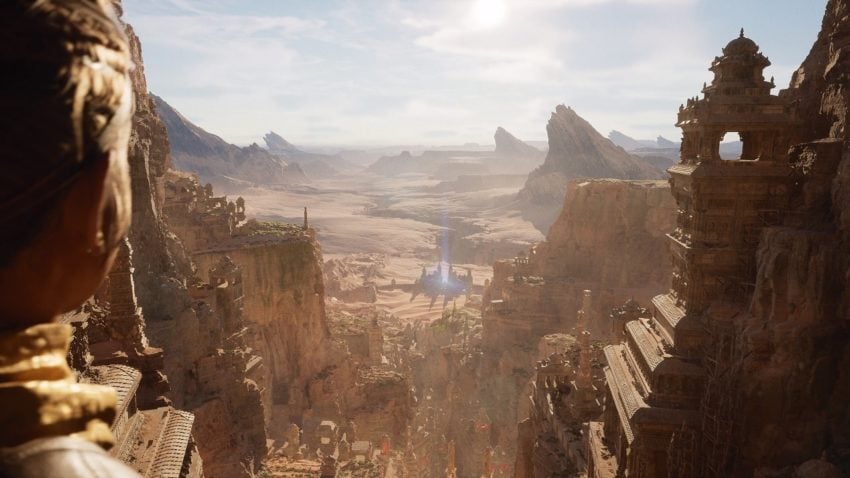On May 13, Epic Games unveiled a tech demo that showcased what games built for the next generation of consoles could look like. The nine-minute demo was presented by Geoff Keighley of The Game Awards during the Summer Games Fest and was followed by an interview with the developers at Epic Games, including CEO Tim Sweeney.
While the footage looks incredibly exciting, the tech demo was simply to demonstrate the capabilities of the next-generation engine running on a PS5. But what do we know about the engine? Here are the takes from the showcase.
Nanite
Firstly, what you see on screen. Each and everything you see on screen is using the engine’s Nanite technology. Each element you see on screen is a polygon that has been sculpted by an artist, scaled-down, and then added to the game. The scaling down process can take time as typically, art is made to very high detail, and then it is ‘baked’ to a lower scale, where it is molded to fit in lower resolution textures. This allows it as an asset to be smaller in file size and fit onto a particular scene of a game, now with lesser detail due to this process.
The idea with Nanite tech is that artists creating models in professional software, such as ZBrush, can now import the model directly into the engine without the need for the baking process, and it will simply work within the game that it’s being implemented into.
But what does this mean for the player? Well, this means that the process of scaling down assets, which can take a huge amount of time simply due to the number of assets that most modern games contain, will either be much shorter or removed completely. This results in faster and cheaper production, meaning that the game could potentially be with you faster, or there will be more time and money for developers to polish other elements. Assets also could be more detailed than ever before, even very close-up. The only downside to this is that it could mean an increase in file sizes as more detail means more space is needed for the asset.
Lumen
In current video-game development, lightning and shade is something that is added to a game in a very deliberate way. If you see lighting in a particular scene shining down on an object, this is because the developers have taken the time to measure and calculate where the light is entering the scene, and added this light to the scene via a similar baking process to the asset scaling mentioned previously.
Similar to the asset scaling process, this can take time and money for a developer to adjust and get right for every situation that the player might be entering. It’s predetermined, so typically you won’t see the light move from its position.
Lumen, introduced with Unreal Engine 5, is a new lighting system that allows the game developers to adjust the lighting of a scene in real-time. This allows light to dynamically change and bounce an infinite number of times. An example of this is the change in the time of day, where the game sees reflections in one direction, and without changing the scene, the game can adjust the lighting and shadows accordingly as the sun moves throughout the daytime. That would require a painstaking amount of work in current conditions, but with Lumen, the engine does the work.
For players, this should result in games that offer unparalleled immersion if the tech works as described by Epic.

Compatibility with Unreal Engine 4
One of the biggest obstacles that developers on Unreal technology faced was the jump from Engine 3 to Engine 4. It was, in effect, a completely different engine, and so converting a game from one to the other was akin to creating a completely new game.
Not so this time, as the process of converting from Engine 4 to Engine 5 has been designed to allow for easy conversion.
This means that any developers currently working on games that were originally created in Unreal Engine 4 should see the upgrade to the new engine as a much simpler process, and allow for easy conversion to the new consoles. This means that all of the new features of Engine 5 can be utilized on existing code and improvements made easy when porting to a new-gen console.
Epic has already confirmed that their premier game Fortnite will see a conversion to Unreal Engine 5, though they didn’t provide any timescale as to when this might be implemented aside from mid-2021. The game will launch on PS5 and Xbox Series X on Unreal Engine 4.
Compatibility with all platforms
Much like Unreal Engine 4 currently does, the new engine will be able to integrate and run on just about every platform that is currently available on the market, including the current generation of game consoles. The PS5 and Xbox Series X will see the biggest benefit from the engine with the ability to use all of the extra computing power, but the engine will be compatible with the PS4, Xbox One, PC, macOS, mobile platforms and Nintendo Switch.
This means that while the previous generations of game consoles may not be able to demonstrate quite as impressive a leap as next-gen, the workflow of the game creation process should still see improvement. This means that games still being produced on the current generation consoles should see time and costs to develop come down when developing on Unreal Engine 5.
When does it launch?
For those developers looking to get to grips with the new engine, the preview builds are set to launch in the early part of 2021, with the full release set to take place towards the end of 2021.
For those looking to know when they might start to see new games on the technology, it’s likely to be a while yet. Games can be ported from Unreal Engine 4, but all of the base upgrades would likely take time to implement. This means that the first set of games that will take advantage of the power of Unreal Engine 5 will not be until 2022 at the earliest. However, the next generation will be in full swing, and players can start to expect bigger results from developers.







Published: May 13, 2020 02:32 pm